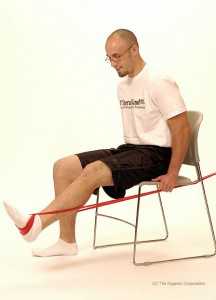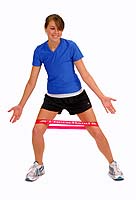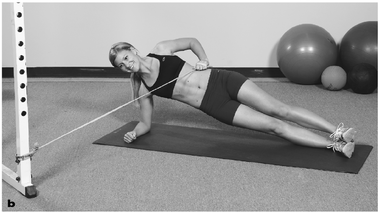 Strength Band Training co-author Dr. Phil was featured in the December issue of Oxygen magazine, devoted to women’s fitness. The article, “Your Perfectly Portable Gym” featured 5 exercises that save time and provide a challenging workout for women using elastic tubing.
Strength Band Training co-author Dr. Phil was featured in the December issue of Oxygen magazine, devoted to women’s fitness. The article, “Your Perfectly Portable Gym” featured 5 exercises that save time and provide a challenging workout for women using elastic tubing.
Elastic resistance is a versatile and widely used tool to increase strength. While elastic bands and tubing are prevalent in rehabilitation and fitness, some have speculated that elastic resistance may not provide an adequate stimulus for athletes.
 Researchers at the University of Malaysia compared the muscle activation and force output of the quadriceps muscle in 16 healthy subjects. They performed a knee extension exercise against an 8 RM (high intensity) resistance using a Nautilus machine and against Thera-Band® elastic tubing. The tubing was tested both in the original length (equal to the length of the lower leg) and at a length that was 30% shorter. The researchers used different combinations of Thera-Band colored tubing to achieve an 8RM resistance.
Researchers at the University of Malaysia compared the muscle activation and force output of the quadriceps muscle in 16 healthy subjects. They performed a knee extension exercise against an 8 RM (high intensity) resistance using a Nautilus machine and against Thera-Band® elastic tubing. The tubing was tested both in the original length (equal to the length of the lower leg) and at a length that was 30% shorter. The researchers used different combinations of Thera-Band colored tubing to achieve an 8RM resistance.
The researchers found that the 30% shorter elastic tubing produced the same levels of muscle activation during mid-range of motion compared to the Nautilus machine. It also appeared that elastic resistance elicits higher levels of muscle activation at lower levels of applied force. The Nautilus machine exercise produced significantly more activation of the quadriceps during the beginning and end of the exercise, however.
These findings are supported by previous research:
- Other researchers (Colado & Triplett 2008; Rogers et al. 2010) have shown that Thera-Band-resisted exercise programs produce strength gains similar to expensive weight machines.
- Electromyography (EMG) studies have confirmed that Thera-Band elastic resistance produces similar EMG levels to isotonic free weights (Andersen et al. 2010) and pulley systems (Nelson et al. 2003).
In addition, a recent study suggested that elastic resistance should be favored over isotonic resistance because of the higher level of neuromuscular activation particularly during the eccentric phase of the exercise (Melchiorri and Rainddi, 2011), making it useful for rehabilitation.
The authors concluded that elastic resistance “can be suggested as an affordable and non-gym based exercise device which has the capacity to provide an appropriate high resistance stimulus to meet the training requirement of athletes.” Therefore, elastic resistance provides a cost effective and clinically effective strength training modality in both rehabilitation and fitness.
REFERENCE: Aboodarda SJ et al. 2011. Electromyographic activity and applied load during high intensity elastic resistance and nautilus machine exercises. J Human Kinetics. 30(1). Available online at http://johk.pl/files/01-aboodarda.pdf
Shoulder rehabilitation often includes Thera-Band® exercises. One popular exercise is the “PNF” diagonal shoulder exercise from the Proprioceptive Neuromuscular Facilitation concept. The PNF diagonal exercise includes tri-planar motion of the shoulder against resistance; the resistance provided can be manual, dumbbell, or elastic band resistance. Few researchers have investigated the EMG activation levels of shoulder muscles during PNF diagonal exercises.
Researchers at the University of Cincinnati in Ohio assessed the activation of scapular muscles in 21 healthy subjects. The subjects performed 4 diagonal patterns (D1 Flexion, D1 Extension, D2 Flexion, and D2 Extension) with both a 3 pound dumbbell and a blue Thera-Band resistance band. For the band exercises, the subjects were seated using a length of band equal to the distance between the floor and their greater trochanter as measured when the subject was standing.
The results showed that both Thera-Band and dumbbell exercises provide similar levels of EMG activity, which is consistent with findings of other researchers who compared EMG levels during isotonic and elastic resistance (Andersen et al. 2010). The serratus anterior, an important scapular stabilizer, remained moderately active in each exercise with no significant difference between exercises (42.5 to 50% of maximal).
When evaluating an exercise for suitability in rehabilitation, it’s important to consider not only the absolute activation but the activation relative to other muscles including agonists and antagonists. The trapezius is prone to muscle imbalance. The upper portion is prone to tightness and the lower portion is prone to weakness according to Janda. Shoulder patients, particularly those with impingement, often exhibit scapular muscle imbalance.
The D2 Flexion pattern had the highest activation levels for the middle and lower trapezius compared to the other patterns; the D1 and D2 flexion patterns also had more upper trapezius activation than their extension movement counterparts. While the Thera-Band resisted D2 Flexion exercise produced higher levels of middle and lower trapezius activation compared to dumbbell resistance, the Thera-Band resistance also produced higher levels of upper trapezius activation compared to the dumbbell.
| Upper Trap | Middle Trap | Lower Trap | |
| D2 Flexion Dumbbell | 39.6% MVIC | 18.4 | 23.7 |
| D2 Flexion Thera-Band | 68.5 | 45.3 | 44.9 |
In contrast to D2 Flexion, the D2 Extension exercise with Thera-Band had the lowest levels of upper trapezius activation. It also had the most desirable ratio of upper to lower trapezius activation (0.9), meaning the lower trapezius was activated at a higher level than the upper trapezius.
As with other surface EMG studies on healthy subjects, these results should be used with caution in patient populations. The authors chose blue Thera-Band resistance, which may not be appropriate in early stages of rehabilitation. It would have been valuable for the authors to report on the eccentric phase of the exercise, or during different phases of the exercise due to the large arc of motion.
The authors concluded that the D2 Flexion pattern with either dumbbell or Thera-Band resistance provides the greatest activation of scapular muscles, and the D2 Extension pattern with Thera-Band provided the best ratio of upper and lower trapezius activation.
REFERENCE: Witt D, Talbott N, Kotowski S. Electromyographic activity of scapular muscles during diagonal patterns using elastic resistance and free weights. Int J Sports Phys Ther. 2011 Dec;6(4):322-32.
 Strength Band Training co-author, Dr. Phil Page was recently featured in the January 2012 issue of Prevention Magazine. He was asked to develop a workout option for the feature, “One Woman / Three Workouts,” where 3 fitness professionals suggest a workout routine for someone in need of a specific fitness goal. Download the featured article here. Dr. Page’s program included the Thera-Band® Band Loop.
Strength Band Training co-author, Dr. Phil Page was recently featured in the January 2012 issue of Prevention Magazine. He was asked to develop a workout option for the feature, “One Woman / Three Workouts,” where 3 fitness professionals suggest a workout routine for someone in need of a specific fitness goal. Download the featured article here. Dr. Page’s program included the Thera-Band® Band Loop.
Brenda McColgen wanted a routine that improve her muscle tone, particularly in her legs. Of the three workouts, she said she chose the band loop routine because, “I loved that I could do the moves anywhere— watching TV, checking e-mail—and that the bands traveled easily!”
Co-author of Strength Band Training, Todd Ellenbecker, uses elastic resistance, including Thera-Band® products, as the Director of Sports Medicine of the ATP World Tour for professional tennis players. The ATP World Tour website recently ran a story on how ATP players and physiotherapists use elastic resistance bands for training and rehabilitation of tennis players.
Below is an excerpt from the article:
“In the case of Andy Murray, if he’s practising moving to his forehand using an open stance with the resistance of the band, he overloads the muscles using the band with that exercise,” explains Ellenbecker. “When he goes to do that movement without the resistance of the band, he’ll be able to do it faster and with less effort because he’s been practising it with the resistance.” Along with Murray, Ellenbecker has seen several top players work out with the bands, including Novak Djokovic, Marin Cilic, Fernando Verdasco and Milos Raonic. “A lot of players use them on the court for these specific movements, like Murray’s doing. We see them putting loops around their ankles, doing the ‘Monster Walk’ which are little side shuffles in different directions to get their hips and core strong.
Buy Thera-Band Elastic Loops here.
Recently, strength and conditioning professionals have been adding elastic resistance to traditional isotonic resistance exercises such as the bench press and squat in an effort to improve strength outcomes. In theory, so-called “variable” resistance (in the form of elastic bands or weighted chains) provides increasing resistance toward the end of the range of motion and helps facilitate power development. A study in the Journal of Strength and Conditioning Research found that adding elastic bands and chains to traditional free-weight barbell exercises may increase maximal strength levels and increase power input.
Adding elastic bands to the ends of barbells produces resistance in ‘parallel’ to the direction of gravity. Researchers in Spain wanted to see if they could produce similar results by adding elastic resistance in ‘series’ with the direction of exercise using a cable column exercise machine. They noted that the combination of elastic resistance with the constant load of the pulley cable should decrease the need for deceleration at the end of the movement, thus enhancing muscle tension throughout the range of motion.
The researchers began by connecting an elastic resistance device in-series with the pulley cable and handle. The resistance of the band was equivalent to the load of the pulley weight stack, representing 70% of one repetition maximum (RM). 21 healthy undergraduate students performed a standing biceps curl exercise to fatigue with 2 conditions: traditional pulley resistance and elastic resistance in series with the pulley. The conditions were counterbalanced with a week in between testing. Data were collected on the number of repetitions to failure, velocity, and rating of perceived exertion (RPE).
Subjects were able to complete 1.5 more repetitions with the traditional isotonic resistance compared to the series elastic condition (average 12.4 versus 10.9 repetitions, respectively) at similar RPE levels (7.9 and 8.2 on the OMNI scale). In addition, there was more decrease in acceleration in the traditional pulley resistance compared to the elastic resistance-enhanced condition, suggesting decreased deceleration as the researchers had postulated.
The researchers concluded that the elastic resistance applied in series to a cable pulley resulted in a smoother and consistent decline in acceleration during the biceps curl exercise. They suggested that a greater average muscle tension could have been achieved throughout the range of motion, leading to earlier fatigue during the elastic condition. Unfortunately, the researchers did not assess muscle activity levels through EMG analysis, which could help confirm this assumption.
In summary, elastic resistance in series with traditional isotonic resistance may enhance muscle stimulus, resulting in a smoother and more consistent contraction. The elastic resistance helps avoid deceleration at the end of the range of motion, which is thought to enhance the benefits of the exercise, and may provide greater increases in muscular hypertrophy according to the authors.
REFERENCE García-López D, Herrero AJ, González-Calvo G, Rhea MR, Marín PJ. Influence of “in series” elastic resistance on muscular performance during a biceps-curl set on the cable machine. J Strength Cond Res. 2010 Sep;24(9):2449-55.
 Anterior knee pain, or patellofemoral pain syndrome is a common condition associated with muscle imbalances, particularly at the hip. These imbalances are thought to lead to biomechanical changes that cause excessive load on the patellofemoral joint and associated structures such as the patella tendon.
Anterior knee pain, or patellofemoral pain syndrome is a common condition associated with muscle imbalances, particularly at the hip. These imbalances are thought to lead to biomechanical changes that cause excessive load on the patellofemoral joint and associated structures such as the patella tendon.
Elastic resistance is often prescribed as part of a physical therapy intervention for anterior knee pain, but its overall efficacy remains unclear. I was asked by the journal Sports Health to write a systematic review of the literature on the effectiveness of elastic resistance in the rehabilitation of patellofemoral pain syndrome patients. As you can imagine, there weren’t many studies, but I was able to come up with 8, peer-reviewed clinical studies that specified the use of elastic resistance.
As with most reviews of clinical trials, it was difficult to make a definitive conclusion based on scientific rigor; however, each study found significant improvements in pain but they were designed without being able to isolate the effect of elastic resistance. From a scientific perspective, the conclusion is that elastic resistance training may help reduce pain and improve function and strength. However, from a clinical perspective, it’s clear that elastic resistance training is effective as part of a comprehensive treatment for patellofemoral pain syndrome.
Clinical trials are often limited in clinical applicability because of a quasi-homogenous population—while all subjects may have patellofemoral pain syndrome, there are a variety of causes that may differ between individuals. For example, some pain may be caused by a functional muscle imbalance, while other pain may be caused by structural misalignment. As with any condition, the clinician must design an intervention specific to the patient based on a thorough history and examination.
REFERENCE: Page P. Effectiveness of elastic resistance in rehabilitation of patients with patellofemoral syndrome: What is the evidence? Sports Health. 2011. 3(2):190-94.
Bottom Line Secrets, a free e-newsletter, recently featured Dr. Phil Page in an article about simple exercises using elastic resistance for muscle imbalance syndromes. He provides simple exercises for knee pain, hip pain, as well as upper back and shoulder pain… Read the entire article below.
Source: HealthyWoman / Bottom Line: December, 2010
Body-Balancing Workout for Pain-Free Joints
When it comes to our muscles, stronger is better, right? Not necessarily. When one muscle is too strong compared to another, it creates an imbalance that leaves our joints vulnerable to inflammation, injury and pain.
According to physical therapist and certified athletic trainer Phil Page, PhD, PT, coauthor of Assessment and Treatment of Muscle Imbalance, as we age, certain muscles typically become overstretched, which weakens them… while certain other muscles tend to shorten, becoming strong but tight. Scientists aren’t sure why this happens (though poor posture is a likely factor), but they do know that it causes abnormal wear and tear on joints.
Example: In the shoulder joint, various muscles pull from different directions on the ball at the top of the humerus (upper arm bone). This keeps the ball perfectly centered in the socket, as it should be. But if the muscles at the back of the shoulder become weak (as they often do) and those in front become strong and tight, the ball is pulled slightly off center… which eventually leads to joint deterioration.
Dr. Page explained that osteoarthritis often follows patterns based on muscle imbalances — for instance, weak muscles in the fronts of the thighs (quadriceps) plus tight hamstrings at the backs of the thighs (hamstrings) contribute to knee arthritis. Muscle imbalances also are associated with tendon problems, such as the painful inflammatory knee condition patellar tendinitis.
Fortunately, we can reduce the risk for such problems with a workout specifically designed to restore balance to joints by strengthening weak muscles (or those likely to become weak) and stretching tight ones.
WORKOUT FOR BALANCED MUSCLES
Since most people are prone to muscle imbalances, the following exercises are appropriate for just about anyone, Dr. Page said. (Of course, check with your doctor before beginning any new exercise program to make sure it is safe for you.) Recommended: Do the moves below every other day as an addition to your usual fitness routine. The only equipment needed is a five-foot-long elastic resistance band (available at sporting-goods stores or from online vendors such as Fitness Wholesale, www.FWonline.com/tbcut.htm, about $3 to $6). Start with the stretchiest band for light resistance… work up to greater resistance by using a stronger band and/or adjusting your hand position. To download a PDF with photos that illustrate the exercises below, visit www.StrengthBandTraining.com/2010/12/exercises-for-muscle-balance and click on the image beneath “Exercises for Muscle Balance.”
To prevent or reduce knee problems…
Strengthen quadriceps. Start: Sit in a sturdy chair, feet together. Loop center of band around right ankle. Grasp ends of band in left hand… anchor exposed portion of band firmly beneath left foot. Move: Slowly extend right leg until knee is straight… hold for two seconds… slowly return to starting position. Do 12 to 15 repetitions (“reps”), then switch sides.
Stretch hamstrings. Start: Lie on your back, right leg straight on floor. Bend left knee in toward chest and loop center of band around sole of left foot. With hands, grasp ends of band. Straighten left leg as much as you comfortably can, sole of left foot facing ceiling. Move: Keeping left leg straight, gently pull on ends of band to bring leg closer to you, until you feel a good stretch at the back of the leg… hold 15 to 30 seconds… return to starting position. Do three to five reps, then switch sides.
To prevent or reduce hip problems…
Strengthen gluteus medius (outer hip). Start: Stand with feet shoulder-width apart. Loop center of band around right ankle… grasp ends of band in left hand… anchor exposed portion of band firmly beneath left foot. Shift weight to left foot. Move: Keeping knees straight and torso erect, raise right leg out to the side about 12 inches… hold for two seconds… slowly return to starting position. Do 12 to 15 reps, then switch sides.
Stretch piriformis (buttocks). You do not need a band for this exercise. Start: Sit in a sturdy chair. Bend left leg and place left ankle over right knee in a figure-four position. Move: Without rounding your back, gently lean forward as far as you comfortably can… hold 15 to 30 seconds… return to starting position. Do three to five reps, then switch sides.
To prevent or reduce shoulder and upper-back problems…
Strengthen posterior rotator cuff (back of shoulder). Start: Tie one end of band around a fixed object (such as the doorknob of a closed door) at waist height… stand so that the object to which the band is tied is on your right side. Wrap free end of band around left hand… bend left elbow to 90° so left hand is nearly touching belly button. Move: Keeping left elbow tucked into your side and forearm parallel to floor, rotate the forearm outward (by rotating at left shoulder joint) so left hand moves slowly to the left (as if on a hinge) as far as you comfortably can… hold for two seconds… return to starting position. Do 12 to 15 reps, then switch sides.
Strengthen rhomboids and middle trapezius (upper back). Start: Sit in a sturdy chair, feet together, legs stretched out in front of you, knees slightly bent… wrap center of band around soles of feet. Grasping ends of band, hold arms out in front of you, angled downward and fairly straight, so hands are at hip height. Move: Bending arms, pull hands in and up toward the sides of your waist, elbows pointing behind you. (Don’t move legs.) Keeping shoulders down, squeeze shoulder blades toward each other… hold for two seconds… slowly return to starting position. Do 12 to 15 reps.
Stretch pectorals (chest). You do not need a band for this exercise. Start: Sit all the way back in a sturdy low-backed chair. Reaching arms behind you (and behind chair back), clasp hands at hip height, interlocking fingers so palms face each other and arms are fairly straight. Move: Keeping head up and neck relaxed, slowly raise arms as high as you comfortably can… hold 15 to 30 seconds… return to starting position. Do two to four reps.
Source: Phil Page, PhD, PT, is a physical therapist, certified athletic trainer and certified strength and conditioning specialist. He is director of the Thera-Band Academy, a fitness education firm, and an instructor of kinesiology at Louisiana State University, both in Baton Rouge. He is the coauthor of three books, including Assessment and Treatment of Muscle Imbalance and Strength Band Training (both from Human Kinetics). www.Thera-BandAcademy.com
The Pittsburgh Post-Gazette recently had an article on elastic resistance training, “Resistance bands grow in popularity.” The second edition of Strength Band Training featuring Thera-Band resistance is also featured in the article. The article describes how physical therapists use the bands to rehabilitate body parts from the shoulder to the ankle, and from patients in wheelchairs to professional athletes. Fitness professionals suggest elastic resistance bands are increasing in popularity over free weights or weight machines.
Total-Body Exercises
Excerpt from Phil Page and Todd Ellenbecker's Strength Band Training
Athletic and functional movements require a strong core consisting of the muscles surrounding the trunk and pelvis: the abdominals and the low back. These muscles must function as movers, stabilizers, and force transducers. Functional strength of the upper extremities (used in actions such as throwing a baseball) is often built initially by the lower body and transferred through the core. While it's important to strengthen these areas individually, it's just as important to integrate these areas into functional strength through total-body exercises.
Functional training programs should always include total-body exercises that facilitate core stabilization and force transmission between the upper and lower extremities. Elastic resistance exercises can create different vectors of resistance that challenge core stabilization muscles through extremity movement combined with movements such as squats or lunges. In addition, elastic resistance exercises can challenge the muscles involved in whole-body functional movements such as a lift or a push with a step.
Unilateral Row With Side Bridge
(Rhomboids, Quadratus Lumborum)
Secure one end of the band to a sturdy object near the floor. Lie on your side with your elbow directly under your shoulder. Use your other hand to grasp the band and perform a single-arm rowing exercise while lifting your hips off the floor and stabilizing the side bridge position. Slowly return.
VARIATION
Perform the side bridge while lifting your arm upward toward the ceiling with your elbow straight until the arm is vertical.
TRAINING TIP
Keep your body in alignment, tensing abdominal muscles and gluteal muscles.
Excerpted from Strength Band Training, Second Edition (Human Kinetics, 2011). For more information on Strength Band Training, Second Edition or other strength and conditioning resources, visit www.HumanKinetics.com or call 1-800-747-4457.



